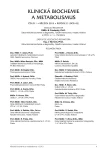Changes in serum levels of markers in early detection of prostate cancer (pilot study)
Authors:
R. Fuchsová 1; O. Topolčan 1; J. Klečka 2; J. Vrzalová 1; M. Hora 2; R. Kučera 1; O. Dolejšová 2; O. Hes 3
Authors‘ workplace:
Laboratoř imunochemické diagnostiky, FN a LF v Plzni, Univerzita Karlova v Praze
1; Urologická klinika, Fakultní nemocnice v Plzni
2; Šiklův patologicko-anatomický ústav, FN a LF v Plzni, Univerzita Karlova v Praze
3
Published in:
Klin. Biochem. Metab., 21 (42), 2013, No. 1, p. 21-24
Overview
Objective:
Monitoring changes in the levels of biomarkers PSA, %fPSA, [-2]proPSA and calculation of PHI in the diagnostic algorithm of early prostate cancer.
Design:
Pilot study
Material and Methods:
The Immunoanalytical Laboratory of University Hospital in Pilsen examined sera of 76 patients from the Urology department of the University Hospital with suspected prostate cancer who have undergone TRUS biopsy. We assessed the levels of PSA and, if the interval of PSA was between 0-30 µg/l, we also assessed the levels of freePSA, [-2]proPSA and we calculated %fPSA and Prostate Health Index (PHI). The monitored biomarkers were measured using the chemiluminescent DxI 800 instrument (Beckman Coulter, USA). All statistical analyses were calculated using the SAS version 9.2 software.
Results:
We found statistically significant increased levels of [-2]proPSA and PHI in patients diagnosed with prostate cancer by prostate biopsy vs. patients with benign prostate hypertrophy ([-2]proPSA median 14 vs. 27 ng/l, PHI median 35 vs. 77). On the contrary, we did not find any significant difference in tPSA and %freePSA (median tPSA 7.1 vs. 7.7 µg/l and %freePSA 16 vs.11.4%).
Conclusion:
The assessment of [-2]proPSA and the calculation of PHI appear to be of great benefit for a more accurate differential diagnosis of benign hyperplasia.
Key words:
PSA, fPSA , [-2]proPSA , PHI, prostate health index, prostate cancer, biopsy, benign prostate hypertrophy
Sources
1. Shariat, S. F., et al. Tumor Markers in Prostate Cancer I: Blood-Based Markers. Acta Oncologica (Stockholm, Sweden), 2011, vol. 50 Suppl 1, s. 61-75, ISSN 1651-226X, 0284-186X.
2. Makarov, D. V., et al. Biomarkers for Prostate Cancer. Annual Review of Medicine, 2009, vol. 60, s. 139-151, ISSN 1545-326X, 0066-4219.
3. Heijnsdijk, E. A., et al. Overdetection, Overtreatment and Costs in Prostate-Specific Antigen Screening for Prostate Cancer. British Journal of Cancer, 2009, vol. 101, no. 11, s. 1833-1838, ISSN 1532-1827, 0007-0920.
4. Klečka, J. et al. Nádorové markery karcinomu prostaty. Ces. Urol., 2008, 12(3), s. 173-185.
5. Catalona, W. J., et al. A Multicenter Study of [-2]Pro-Prostate Specific Antigen Combined with Prostate Specific Antigen and Free Prostate Specific Antigen for Prostate Cancer Detection in the 2.0 to 10.0 ng/ml Prostate Specific Antigen Range. The Journal of Urology, 2011, vol. 185, no. 5, s. 1650-1655, ISSN 1527-3792, 0022-5347.
6. Sokoll, L. J., et al. A Prospective, Multicenter, National Cancer Institute Early Detection Research Network Study of [-2]proPSA: Improving Prostate Cancer Detection and Correlating with Cancer Aggressiveness. Cancer Epidemiology, Biomarkers & Prevention: A Publication of the American Association for Cancer Research, Cosponsored by the American Society of Preventive Oncology, 2010, vol. 19, no. 5, s. 1193-1200, ISSN 1538-7755, 1055-9965.
7. Khan, M. A., et al. Evaluation of Proprostate Specific Antigen for Early Detection of Prostate Cancer in Men with a Total Prostate Specific Antigen Range of 4.0 to 10.0 ng/ml. The Journal of Urology, 2003, vol. 170, no. 3, s. 723-726, ISSN 0022-5347, 0022-5347.
8. Roehl, K. A.; Antenor, J. A.; Catalona, W. J. Serial Biopsy Results in Prostate Cancer Screening Study. The Journal of Urology, 2002, vol. 167, no. 6, s. 2435-2439, ISSN 0022-5347, 0022-5347.
9. Catalona, W. J., et al. Use of the Percentage of Free Prostate-Specific Antigen to Enhance Differentiation of Prostate Cancer from Benign Prostatic Disease: A Prospective Multicenter Clinical Trial. JAMA: The Journal of the American Medical Association, 1998, vol. 279, no. 19, s. 1542-1547, ISSN 0098-7484, 0098-7484.
10. Mikolajczyk, S. D., et al. Free Prostate-Specific Antigen in Serum is Becoming More Complex. Urology, 2002, vol. 59, no. 6, s. 797-802, ISSN 1527-9995, 0090-4295.
Labels
Clinical biochemistry Nuclear medicine Nutritive therapistArticle was published in
Clinical Biochemistry and Metabolism

2013 Issue 1
Most read in this issue
- Significance and possibilities to examine brain metabolism in neurointensive care by microdialysis
- Changes in serum levels of markers in early detection of prostate cancer (pilot study)
- Number of cells in the cerebrospinal fluid, energy relations in the cerebrospinal fluid compartment and intensity of inflammatory response in the central nervous system
- The prevalence of decreased glomerular filtration rate in patients with monoclonal gammopathy of undetermined significance
